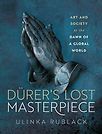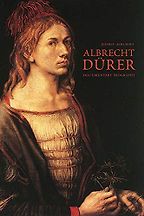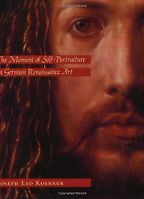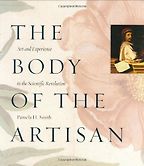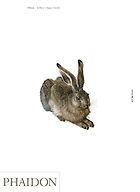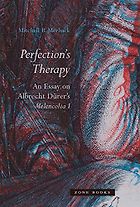Before we start talking about the books that you selected about him, tell me: who was Albrecht Dürer?
Albrecht Dürer was one of the greatest artists who ever lived. He is famous for the quality of his prints, with woodcuts and engravings that really can’t be rivalled by anyone today. Everyone who sees one of his master prints, ‘Melencolia I’, say, ‘The Knight, Death and the Devil’ or ‘St Jerome’ is struck by the vividness of the detail in it. It is astonishing to see the extraordinary labor that Dürer was able to put into these and other works, in depicting such fine lines, but also the inventiveness of his approach to composition, and the way he captures emotional states.
He was a German artist who was born in Nuremberg in 1471 and lived most of his life in that city. That matters, because he was not a court artist. This was very unusual for his time. During the Renaissance artists with the patronage of a court had a lot more liberty, often, and much richer as well as more interesting materials to work with. This was especially true in Italy, for example, if you worked for the Papal court. Dürer was certainly interested in taking commissions and gaining honours from the Holy Roman Emperor, but he did also try to preserve his independence. He wasn’t completely beholden to the court.
In short, all the evidence points to an artist for whom it was very important to show that he was more than a craftsman. That is why Dürer projected himself a lot of the time as working very independently, which was very unusual for the time. But this also means that we know relatively little about who was working in his workshop when, and for how long. That projection and self-conception also comes across in the very extensive written record he left behind.
Speaking about the the written word sets the stage nicely for a discussion of the first of the Dürer books on your list, by Jeffrey Ashcroft. In your own book, Dürer’s Lost Masterpiece, you document Dürer’s often obsessive accounting, his journaling. He was surely among the first artists to leave behind quite so much textual evidence of his creative and commercial endeavours. How do all these documents as presented by Ashcroft help us to nuance our image of Dürer as an arrogant and clear-eyed man?
I really honour the extraordinary work of translation Ashcroft accomplished, making these sources available with extensive editing and footnotes. Every specialist will still rely on the German edition from which he translates most of this, but it remains an astonishing work to have completed and far superior to anything else that was available in English, not least because Dürer wrote with a very strong Franconian dialect. To be able to delve into this accurately and very scrupulously think about the translation is a great achievement.
Some years ago I talked to a friend and art critic in England and she asked me, ‘Do you like Dürer?´I found this incredibly enabling. Before I spoke to her, it hadn’t occurred to me that you might not like Dürer. Growing up in Germany, I was raised with a very strong image of ‘Dürer the genius’. In Anglo-American discourse, increasingly, because of a focus on his self-portraits, there is an emphasis on him as almost arrogant. Dürer has become the ‘selfie man’, the man who plays these strategies for self-aggrandisement.
As a corrective, it’s very important to point out that he did not paint another portrait of himself on a self-standing panel after 1500. So it’s not as if he went on doing that over and over again, throughout his life. Think of Rembrandt, by contrast!
You almost have a crescendo of self-portraits, later in life, where Rembrandt is documenting his advancing age and looking back wistfully at the years behind him. All of Dürer’s self-portraits are young.
For me, the complexity of Dürer’s character really comes through on a close reading of the sources he’s left behind. For example, I analysed the nine letters he wrote to a patron in Frankfurt, a merchant named Jakob Heller who had commissioned an altarpiece. These letters are challenging sources to interpret, because you can easily read them as very strategic or tactical — what Dürer wants is to get paid almost double what he had asked for at first.
“Growing up in Germany, I was raised with a very strong image of ‘Dürer the genius’”
On the other hand, and in contrast with his impulse to measure his recognition in terms of how much he was paid, we know from many documents that he felt pressure to provide for his family and lead what we might call a middle-class life. It was only later, when he developed his printmaking, that he became actually astonishingly wealthy in Nuremberg. In his early collaborations with patrons, he’s trying to make a decent living, and given his talent, he’s quite right to insist on that. We also get a sense of Dürer’s passion for complex painting commissions when he got really involved with them.
The falling out that he had with Heller points to a curious dance between artists and patron, oftentimes very fraught.
What we get from across the writings of the time, his own and those of others, is the sense of someone who wants to be recognised and independent, but who’s also struggling with something else. And that is that he received relatively little formal education. When he writes a dedication for his ‘Treatise On Measurements’, he even hired a ghostwriter to do that for him, he was that uncertain. Then he’s not very happy with the ghostwriter! I’ve asked other Renaissance specialists, and it’s quite a singular thing to be doing.
He’s someone who can obviously feel and express that he is probably the best painter of his age, and to defend that viewpoint. But he’s also someone who can feel very vulnerable and who’s striving hard to accommodate to that Italian humanist ideal that’s forming among Renaissance artists, as exemplified by the writings of Alberti and Jacopo de’ Barbari. This ideal maintained that it’s not enough to paint extremely well. As an artist worth his salt, you have to be super inventive all the time, it’s also that you have to speak very elegantly, even to be able to write poetry. Dürer tries his hand at poetry, and it is a disaster. His poems are really bad, and he gets ridiculed for them. They too reveal a very different voice from him than what we might expect, actually rather pious and concerned with housekeeping and domestic affairs.
So what’s interesting to me in registering all these voices that ran through Dürer’s texts and clearly his own mind is how often they are difficult to reconcile with one another, although that, of course, reflects back to the very different lives he was leading and obliged to lead, in a sense, in order to attain this Renaissance ideal of self-fashioning. Although he had quite a libertarian streak, he went to church several times a week. He was very close to his mother, while she was alive, a very devout and anxious and religious woman. The company he kept, however, often revolved around moneyed classes, merchants who were risk-taking and acquiring the luxuries and expensive novelties of the day.
In other words, through a review of the Dürer archive, I wanted to arrive at a more complex image of him as an artist and individual, in that astonishing time where so many different strands of experiences and discourse run parallel to each other. I see a man struggling to make sense of them all and struggling to project himself into the drama. In addition, the Reformation movements emerge as further backdrop, to make everything even more troublesome.
Your new book gives a very vivid sense of these times. It is full of many wonderful illustrations not just of Dürer’s artwork but of objects from the period. I almost felt like I was stepping into his atelier, or the home of one of his many patrons, and really getting a sense for the environment in which he worked. What compelled you to write Dürer’s Lost Masterpiece?
Many people come to Dürer early in life as children. He had such a wonderfully engaging way of observing nature — just think of the famous image of the hare, for example, which has become very familiar. Growing up in Germany, Dürer was extremely prominent. As a child I was taken to see his house in Nuremberg, I collected postcards by him. And yet, I only discovered much later that he had written a lot, and that we could actually find out a great deal about him as a person from his writings as much as his art. For me, this was a discovery that demystified him in certain ways. It became possible to know Dürer as an individual. So I think what motivated me is threefold, and it also speaks to the books I’ve chosen, all of which seek to honour his extraordinary abilities and achievements.
Firstly, I was very intrigued by him as a person, with the way he dealt with the very real commercial pressures of his time, a period of rapid economic and social transformation. Secondly, in a very Renaissance way, he felt pressure to project himself and fashion himself, something we will discuss later. Thirdly, on my reading of the many texts he left behind, I wanted to show that he was actually a challenging and contradictory character. Although he succeeded in his self-fashioning, and arguably to a greater degree than most of his peers, he also had to pay a price for his choices. Instead of ending up with a linear narrative that goes from his beginnings in print to the Christ-like self-portrait from 1500 for which he is so famous, and artistic success after success, we end up with a much more interesting and fractured narrative.
Five Books interviews are expensive to produce. If you're enjoying this interview, please support us by donating a small amount.
Moreover, this narrative doesn’t end with his death. So part of the book then asks, how well-known was Dürer after his death? He was certainly well-known for his drawings and prints. But after 1511, he gave up doing these extraordinary altarpieces. The story of why he did that, what triggered this change of direction, is at the heart of my book. The analogy I use is literature, or music. If you had it in yourself now, say, to write a complex novel, and you decided not to do that, and instead write a short story; or if you had it in yourself to compose a symphony, and you said, ‘No, I’m doing short chamber concert pieces’. That’s a fairly radical and unusual position. That’s the decision he made, a decision of extraordinary magnitude when, after falling out with Jakob Heller, he decided not to take on new commissions for altarpieces anymore.
Next, I retell the story of what is commonly known as the Dürer Renaissance, well after his death. I analyse why it is that collectors like the big Fugger merchants in the 1570s were so keen on very different things from collectors in the past, like coral and shells and other types of rare and unusual items. They might not have mentioned Dürer at all in their writings or their inventories. Why is it that even the first extensive cabinet of curiosities in Munich of the art collectors featured works by Dürer but wouldn’t label them?
This then changed at the end of the 16th century and is commonly framed as a Dürer Renaissance. It was the moment when big collectors like Emperor Rudolph II in Prague and Duke Maximilian I of Bavaria built up their painting galleries and became very keen on old masters. They tried to cream off every Dürer painting they could get their hands on. This went alongside other very different tastes in rarities and curiosities. I want to show just why that was. Dürer himself was a collector and also a purveyor of these consumerist luxuries at a time when cabinets of arts and curiosities, the Kunst-und-Wunderkammern, became all the rage around Europe.
Let’s talk about the second of the books you selected, Dürer by Jeffrey Chipps Smith, which is a beautifully illustrated biography. I suppose if one were to look for a one-stop kind of window shop for Dürer this this could be a good place to start? How does this book present some of the key moments of Dürer’s life?
Chipps Smith I would definitely recommend as still the best go-to biography. It’s beautifully illustrated and really takes you through key moments in Dürer’s life. And with that same balance of on the one hand, demystifying him, and also on the other hand obviously honouring him. This book helps us to understand some of the key stages in Dürer’s life, starting in his childhood. One thing to say about his early life is that he’s trained by his father, an accomplished goldsmith. He could have taken over his father’s workshop and made a good living. At age 13, however, he breaks away from that, and tells his father that he wants to be a painter, a declaration that his father finds very difficult to accept, because he’s already older and ready to hand over the family enterprise. It would have been his wish that his son continued the workshop. Eventually, he gives in.
Dürer then trains with a painter, and next gets immersed in the world of print. This is at a time when print is obviously exploding with the media revolution that came with the development of the printing press. Dürer goes to Basel and is involved in several very exciting new projects, like Brant’s highly illustrated Ship of Fools. When Dürer returns to Nuremberg he’s already older than his peers would have been at a time when they would have just done an apprenticeship and taken over their father’s workshop. He marries a woman who, like Dürer’s own mother, has family links to the local elite of patricians. That’s quite important, because his social position was always a step above otherwise rather normal artisans. What we would today call status asymmetry was something he was aware of, given the higher social standing of his own wife and his mother in Nuremberg society.
“One of the real treasures that has become more important for research is the diary Dürer kept”
Artistically, at about this time he burst onto the scene with highly innovative commercial formats, like a whole little book with a series of religious woodcuts. He also tries to make a name for himself as a portrait painter, and a painter of altar scenes. Although he’s feted very early on, this does not always translate into lucrative commissions. In 1506, for example, letters show that he was in Venice — did he go once or twice to Venice? the jury’s out — but we know that he needed a loan to even be able to make that trip.
The next big decision in 1511 is no longer to paint altarpieces. 1514 saw the next landmark of the creation of what are today called the three master prints: ‘The Knight, Death and the Devil’, ‘Melencolia I’ and ‘St Jerome’. It is a fascinating moment. Fantasy is seen as something fairly ambivalent at the time. Where does your imagination come from? Does it come from the devil? Or is it divinely inspired? These three prints address that question directly. They were hugely inventive, but also artistically just so accomplished. Take the design of ‘St Jerome’, for example, in which you can see the reflections of the noonday sun through the pane windows and on the walls. Each of the three is full of these visual tricks and clearly demonstrate Dürer’s pleasure in executing them.
One of the real treasures that has become more important for research is the diary Dürer kept towards the end of his life in 1520-21 when he was in Antwerp. These diary entries reveal a different Dürer who’s feted by the Antwerp artistic community, even though he does not manage to get commissions from the court of Margaret of Austria. Yet he is clearly highly acknowledged. And he seems to be much more at ease with himself. This is a Dürer who absolutely loves to be in the company of merchants and their trinkets, men of affairs bringing sugarcane from Madeira and rare objects such as featherwork from the Americas. It’s the beginning of a new age for Dürer and a new age of art.
What you sense in each and every one of these episodes is his gradual process of self-fashioning, in that Renaissance sense of the word. Joseph Koerner’s book The Moment of Self-Portraiture we have featured previously, in a discussion on the Northern Renaissance at Five Books.
This is a seminal text in art history because it refers not only to Dürer specifically, but to the evolution of the idea of the artist. The Northern Renaissance, you could say, triggered a kind of paradigm shift. Where previously artists were largely anonymous craftsmen, in this period, they moved to becoming very much active protagonists in the Renaissance cultural drama around them.
Historiographically, part of that interest in self-fashioning was linked to Lisa Jardine’s work, which spoke of Erasmus and men of letters at the time. And Stephen Greenblatt‘s work, too. Koerner’s book took threads from both and applied them to art history by claiming that here we have a kind of antecedent of modernism — there’s a pact between the artist and the beholder. As Koerner puts it in this immensely elegantly written book, it’s almost as if Dürer made sure that one of his self-portraits would be on the cover of every book about the Northern Renaissance.
It’s very cleverly unpacking the way in which Dürer used his monogram obsessively to claim authorship. A literal rendering of the famous AD trademark would say that it was because he simply didn’t want to be plagiarised, at a time when the printing press made reproduction easily accessible. It was also clearly a kind of branding strategy, in the sense that it was a way to make money. Koerner, however, turns it into something that’s more than these practical concerns. For him, the monogram reflects Dürer´s impulse to project himself, not just as a craftsman but as an artist.
What I find very compelling and still very interesting about the book is also the second part, often a bit neglected in discussions of Dürer. It concerns his disciple and close associate Hans Baldung Grien. We know that they were very close because it’s Baldung Grien who inherits one of Dürer’s locks of hair, still preserved in Vienna, believe it or not. And of course, Dürer was immensely proud of his hair! It’s something that brings out so well Dürer’s extraordinary investment in and awareness of his own body.
The Baldung Grien section is very interesting because Koerner claims that Dürer, with his interest in perspective and rather obsessive measurements of proportion, is also interested in a certain idea of order. That is already upended by Baldung, who produced extraordinary woodcuts crammed full of depictions of disorder without a moralising voice — with horses that ejaculate, scenes with little peeping toms in them, where the onlooker becomes complicit through the way in which the visual field is constructed. His prints bring out the wildness of human and animal life while dealing with fantasy. This says something very different about what art can do, how it pleases and unsettles. That is immediately a kind of up-ending of Dürer’s investment in religion and in visual order, including the way that the viewer is implicated in the phenomenon of the artwork itself.
I nonetheless don’t agree with all of Koerner’s characterisations of Dürer as a solitary self-fashioning genius. Pamela Smith’s book, for instance, provides a very different view of Dürer in the context of collaboration.
Let’s talk about that. The Body of the Artisan was a book that reminded me of another that we featured on Five Books, Still Lives by Maria Loh, in which she talks about the embodiment of artistic practice in the Renaissance. You mentioned Dürer’s lock of hair. Artists’ actual bodies became very important, almost talismanic objects in this moment in art history.
There’s one section exclusively on Dürer in Smith’s book. It’s just a few pages long, but that is almost the point. She clearly references Koerner’s ideas, but is intent on showing that Dürer isn’t just about self-portraiture. His work is also very much about observation from nature. This links up to a very different claim, that by patiently and faithfully observing nature, you make knowledge of a different kind. That is a hugely influential idea at the time, and consequential also for the later development of humanism and the Scientific Revolution. She reveals a very different Dürer and inscribes him in a very different tradition, the tradition of many artists involved in a cultural movement. So it seems a much more collaborative effort that he was involved in.
In fact, Dürer himself makes this very explicit in his own theoretical writings, in which he describes what practices he and his circle of fellow artists, artisans and thinkers are engaged in. I think this is so important to remember when looking at a Dürer. This also relates to the great success Smith had with her Making and Knowing project which developed from The Body of the Artisan. In her view, it would be absolutely wrong to look at Dürer merely in terms of his artistic product.
What mattered to him, and again, what the Heller letters bring out so clearly, is that painting at the time was a process that mattered greatly to Dürer. It was absolutely related to the materials that were worked with. Dürer cared very much about finding good colours and make fine pigments and paints. These all had materialised meanings about evoking certain emotional states. They were linked to healing properties, to ideas about how to make people joyful or pensive, how to induce certain states in the viewer. Colours were linked to a whole system of natural philosophy. This is something that Pamela Smith’s work brings out very clearly, that the activity of making is a form of knowing — the very act of making through experimentation meant that the people involved in the making were immersed in the natural philosophies that were enacted. Important though they are, looking at texts or only looking at artistic final products we’re just not getting a view of the whole complex world they came out of and the ways in which artists and viewers were physically and mentally involved in making or seeing paintings.
One thing that comes across very clearly from this book is the extent to which alchemy was a very serious intellectual tradition, much of it founded on the gathering of empirical evidence, as a way to gain insights on the workings of the world.
These days we distinguish very clearly between medicine, alchemy, philosophy. There wasn’t such a delineation between these disciplines during the Renaissance, no hard and fast divide between what you might call science on the one hand, and revelation on the other. Engaging with the world by working with your hands was a way of communing with God.
This perspective, drawn out clearly in Smith’s work, really led me also to reread German humanism and the cultural world Dürer is part of. In fashioning themselves as Renaissance individuals, Dürer and his circle are absolutely not just about textual traditions or high-minded philosophy. All of them are involved in making cosmetics for themselves. They’re all men who want to dye their hair, they make beauty products for themselves and their female friends, invoking all sorts of chemical transformations.
And it’s not just about physical appearance. These efforts are also linked to ideas about healing and longevity. Concerns with alchemy, healing, and medicinal treatments underpin so much Renaissance thinking and continue into the seventeenth century.
This ties in nicely with the theme of Perfection’s Therapy, the last of the Dürer books on your list.
Without a doubt this is amongst the most original recent essays on Dürer. It tackles many aspects of Dürer’s life, art and culture by looking at the print that speaks to so many people today, Melencolia I. It seems to speak to our own endemic battle with anxiety and depression today. What is particularly interesting about Merback’s book is that he first goes through all the interpretations that have been provided to explain this mysterious print. He then builds on those to say that the print was actually intended by Dürer as a kind of active therapeutic image.
This depiction of a melancholic female figure at first glance seems to involve a portrayal of what is so unsettling about a depressed state of mind. There is disorder. Everything that’s lying on the floor, the objects, they seem to be just a random array of this-and-that, unconnected and don’t fall into any order. The central figure’s passivity is also really striking. It appears to be a world that she can’t break out of anymore. She seems to be robbed of agency.
“Dürer was the archetype of the Renaissance man, but also the prototypical artist-merchant, and very much a man of the world”
The print can be situated in that culture where humanist learned people were thinking of themselves as spiritual guides, transforming matter and healing others. It’s a world of the clergy. A third of Nuremberg inhabitants at the time would have been made up of clergy. So the question of how to use images therapeutically for spiritual guidance is central. Art is more than an allegory. It is something very active, a very different perspective from a narrow focus on Dürer himself, instantiating himself and his authorship. He was caring for others. Like other humanist agents at the time, he sees himself as a carer of souls.
Where I disagree with Merback, and this links to what we’ve said in relation to Smith’s approach and my own, is that Merback is amongst those who see Dürer as a perfectionist. It’s very easy to see why you might want to argue that. Many of his prints do bespeak a perfectionism and incredible attention to detail. Again, a close reading of the Heller letters is instructive. Dürer emerges from a craftsman milieu. We do have to see him as someone who actively defines what it is to be an artist, but he also absolutely needs to be re-contextualised within a craft milieu at the same time. He had a very clear sense of how much he’s paid for a particular commission and the effort he would spend to execute it.
In terms of his temperament, it’s simply not the case that he was always perfectionist. He was totally capable of cutting corners to save time where necessary. Some of his work is almost like caricature. He could execute a very quickly painted eye, or he was able to do the most naturalistic eye you can can imagine. His work was constantly calibrated to the task at hand, just like other crafts peoples’.
I love that it’s presented not as some sort of esoteric riddle that requires a solution — a la Dan Brown and his Da Vinci Code — but as a device to alleviate melancholic distress. This was perhaps regarded by many an overworked Renaissance artist as a central affliction?
One facet of Dürer is certainly engaged with that question, but let’s not fall into the trap of the stereotype of Dürer the workaholic. He had his share of mental pressure, but I do think we have to restore a lot of nuance to Dürer. We can do that via his writings, read in historical context. In his late diaries, for example, we find a Dürer who’s really enjoying life. He’s a foodie, he loves fine clothes, he’s very sociable and loves gambling. And even in his work he’s enjoying the pleasure of viewing things, the pleasure of curiosities. He’s constantly engaged and entertained by what he sees.
Of course, he could be anxious about religious change and the big questions of the time. Let’s not, however, overlook the other glimpses we get of Dürer’s multifaceted personality, for instance in the Venetian letters. He was extremely funny! Let’s not overplay that trope of Dürer the melancholic or the solitary artistic genius, lost in contemplation. Dürer was the archetype of the Renaissance man, but also the prototypical artist-merchant, and very much a man of the world.
Five Books aims to keep its book recommendations and interviews up to date. If you are the interviewee and would like to update your choice of books (or even just what you say about them) please email us at [email protected]

